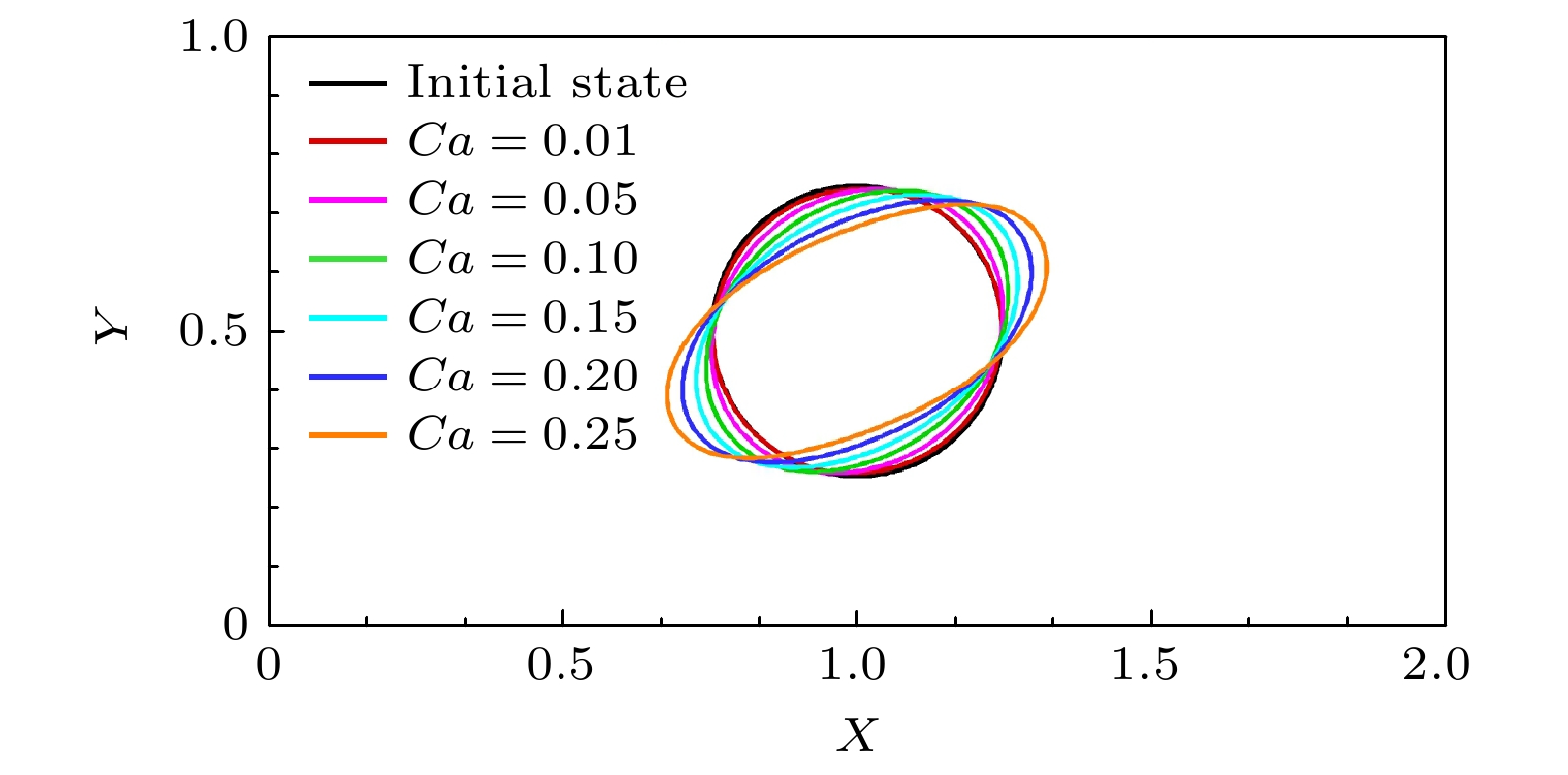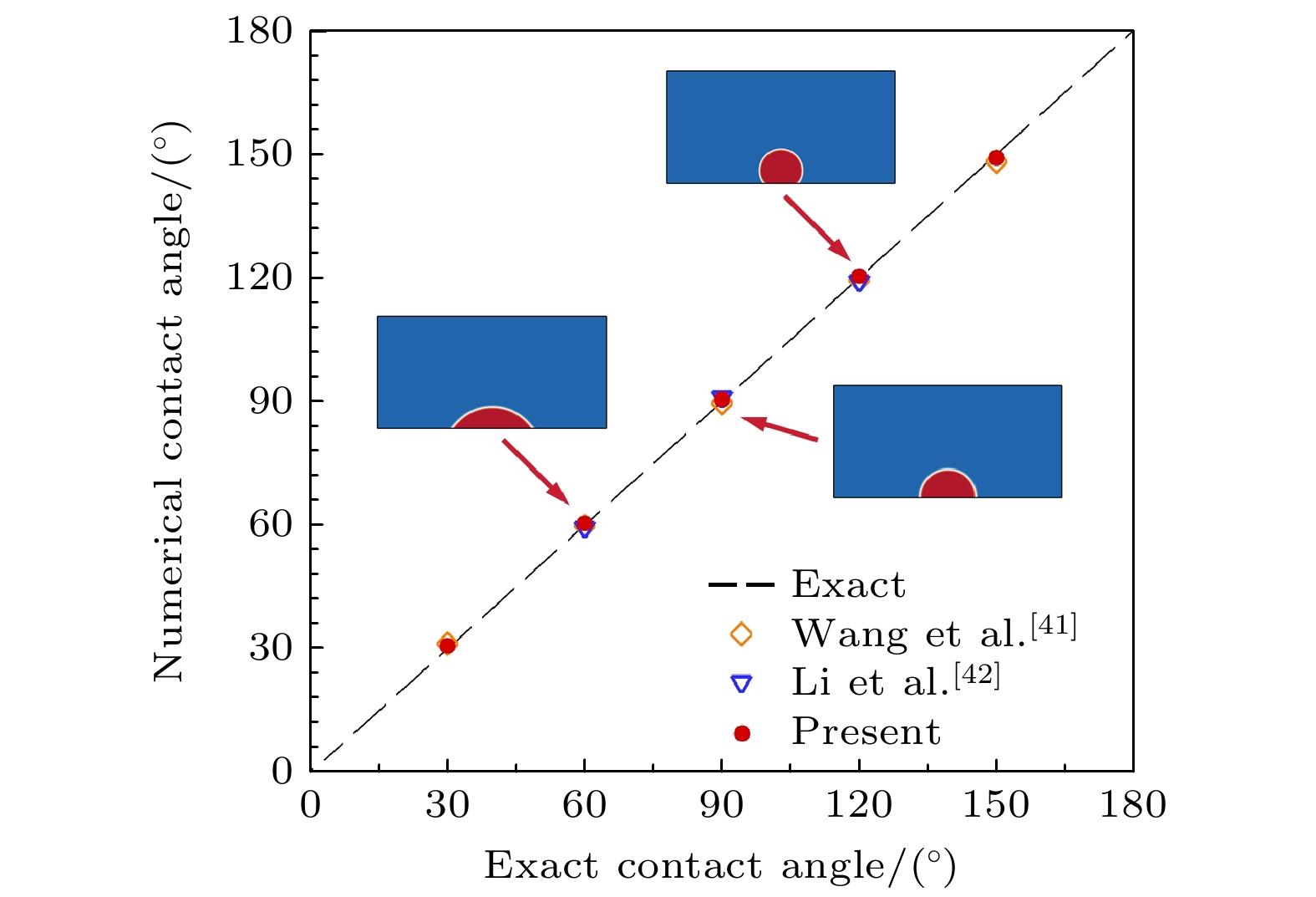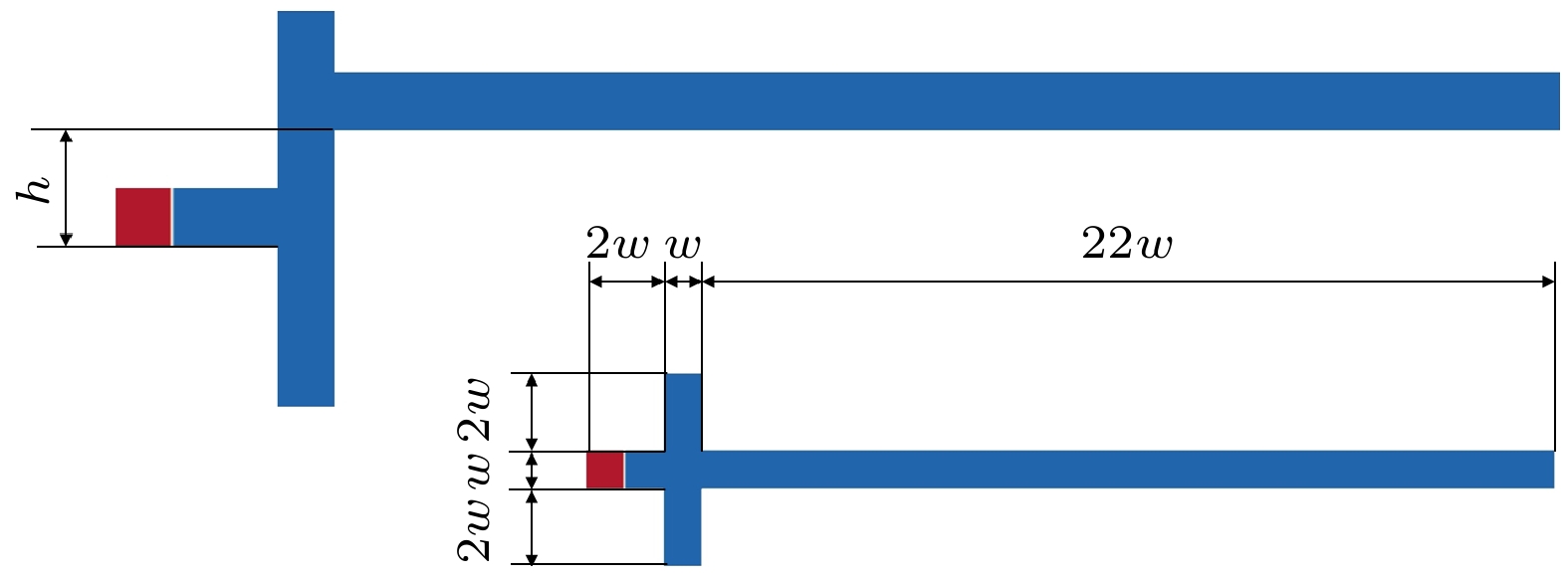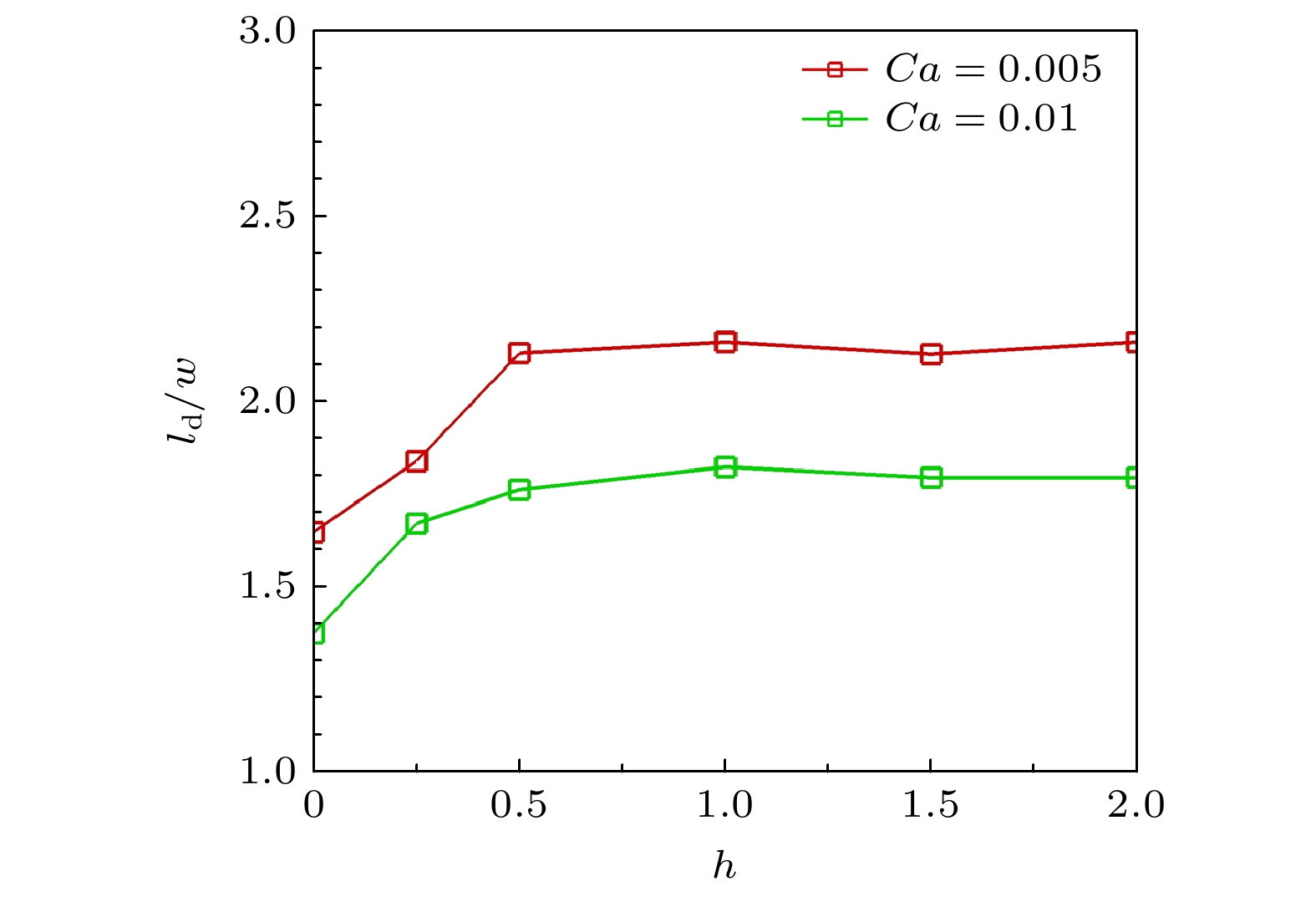-
Droplet microfluidics technology possesses significant potential applications in chemical analysis, biological detection, and material preparation. Passive droplet generation method can rapidly achieve droplet formation by using the geometric characteristics of microchannels and shear flow. As a typical structure, the influences of fluid parameters and symmetry differences in cross microchannels on the droplet generation process have not been fully studied. Therefore, this paper uses the lattice Boltzmann method to numerically simulate droplet generation in symmetric and asymmetric cross microchannels, thereby systematically analyzing the action mechanisms of capillary number, viscosity ratio, and microchannel symmetry. First, this study verifies the computational reliability of the numerical model through two classic cases, i.e. the droplet deformation under planar shear flow and stationary droplets on ideal solid surfaces. Then, this work focuses on studying the three flow stages in symmetric cross microchannels, i.e. interface immersion stage, shear-induced breakup stage, and the droplet migration and coalescence stage, and analyzes the synergistic mechanism of capillary number and viscosity ratio. In the symmetric cross microchannel structure, the capillary number is the main factor determining the droplet size in the cross microchannel. With the increase of the capillary number, the surface tension gradually weakens, causing the liquid bridge at the droplet neck to break more easily and generate droplets. In contrast, the effect of the viscosity ratio on the droplet size is relatively small, but it can suppress the generation of sub-droplets and improve the uniformity of droplets by adjusting the viscous resistance of the continuous phase. On this basis, this study further quantifies the influence of microchannel symmetry on the droplet generation process in cross microchannels. In the asymmetric cross microchannel structure, the microchannel deviation breaks the flow symmetry and weakens the cooperative shearing effect of the oil-phase fluid on the immersion structure of the water-phase fluid. When the microchannel deviates within the centerline range of the water-phase microchannel, the droplet size increases significantly with the increase of the microchannel deviation. This is mainly because the oil-phase fluid on the side far from the deviation first squeezes the immersion structure of the water-phase fluid, and then the oil-phase fluid near the deviation side exerts a secondary squeeze on the immersion structure, causing the neck liquid bridge of the immersion structure to continuously elongate and the shear position to shift along the microchannel deviation direction. When the microchannel deviation exceeds the centerline position of the water-phase microchannel, the interface fracture of the water-phase immersion structure mainly relies on the double squeezing effect of the oil-phase fluid and the surface tension of water-phase fluid, and the droplet size tends to be stable. The relevant research results lay a theoretical foundation for microchannel design and fluid parameter regulation in droplet microfluidics and thus further promote the application and development of droplet microfluidic technology.
-
Keywords:
- droplet generation /
- multiphase flow /
- lattice Boltzmann method /
- diffuse interface method /
- microfluidic technology
-
-
[1] Zhu P, Wang L 2017 Lab Chip 17 34
 Google Scholar
Google Scholar
[2] Cybulski O, Garstecki P, Grzybowski B A 2019 Nat. Phys. 15 706
 Google Scholar
Google Scholar
[3] Chen P C, Wu M H, Wang Y N 2014 Microfluid. Nanofluid. 17 275
 Google Scholar
Google Scholar
[4] Li X, Li D, Liu X, Chang H 2016 Sens. Actuators, B 229 466
 Google Scholar
Google Scholar
[5] Theberge A B, Courtois F, Schaerli Y, Fischlechner M, Abell C, Hollfelder F, Huck W T S 2010 Angew. Chem. Int. Ed. 49 5846
 Google Scholar
Google Scholar
[6] Teo A J T, Tan S H, Nguyen N T 2020 Anal. Chem. 92 1147
 Google Scholar
Google Scholar
[7] Zhang Q, Li H, Zhu C, Fu T, Ma Y, Li H Z 2018 Colloids Surf. , A 537 572
 Google Scholar
Google Scholar
[8] Jin S, Wei X, Liu Z, Ren J, Jiang Z, Abell C, Yu Z 2019 Sens. Actuators, B 291 1
[9] Zhang H, Palit P, Liu Y, Vaziri S, Sun Y 2020 ACS Appl. Mater. Interfaces 12 26936
 Google Scholar
Google Scholar
[10] Thorsen T, Roberts R W, Arnold F H, Quake S R 2001 Phys. Rev. Lett. 86 4163
 Google Scholar
Google Scholar
[11] Zhang Y Y, Xia H M, Wu J W, Zhang J, Wang Z P 2019 Appl. Phys. Lett. 114 073701
 Google Scholar
Google Scholar
[12] Zhang Y Y, Xia H M 2022 Sens. Actuators, B 368 132183
 Google Scholar
Google Scholar
[13] Dreyfus R, Tabeling P, Willaime H 2003 Phys. Rev. Lett. 90 144505
 Google Scholar
Google Scholar
[14] Tan Y C, Cristini V, Lee A P 2006 Sens. Actuators, B 114 350
 Google Scholar
Google Scholar
[15] Chae S K, Lee C H, Lee S H, Kim T S, Kang J Y 2009 Lab Chip 9 1957
 Google Scholar
Google Scholar
[16] Nisisako T, Hatsuzawa T 2010 Microfluid. Nanofluid. 9 427
 Google Scholar
Google Scholar
[17] Liu H, Zhang Y 2011 Commun. Comput. Phys. 9 1235
 Google Scholar
Google Scholar
[18] Rostami B, Morini G L 2019 Exp. Therm. Fluid Sci. 103 191
 Google Scholar
Google Scholar
[19] Yu W, Liu X, Zhao Y, Chen Y 2019 Chem. Eng. Sci. 203 259
 Google Scholar
Google Scholar
[20] Nozaki Y, Yoon D H, Furuya M, Fujita H, Sekiguchi T, Shoji S 2021 Sens. Actuators, A 331 112917
 Google Scholar
Google Scholar
[21] Liu Z, Ma Y, Wang X, Pang Y, Ren Y, Li D 2022 Exp. Therm. Fluid Sci. 139 110739
 Google Scholar
Google Scholar
[22] Umbanhowar P B, Prasad V, Weitz D A 2000 Langmuir 16 347
 Google Scholar
Google Scholar
[23] Utada A S, Lorenceau E, Link D R, Kaplan P D, Stone H A, Weitz D A 2005 Science 308 537
 Google Scholar
Google Scholar
[24] Garstecki P, Fuerstman M J, Whitesides G M 2005 Phys. Rev. Lett. 94 234502
 Google Scholar
Google Scholar
[25] Deng C, Wang H, Huang W, Cheng S 2017 Colloids Surf. , A 533 1
 Google Scholar
Google Scholar
[26] 刘汉涛, 刘谋斌, 常建忠, 苏铁熊 2013 62 064705
 Google Scholar
Google Scholar
Liu H T, Liu M B, Chang J Z, Su T X 2013 Acta Phys. Sin. 62 064705
 Google Scholar
Google Scholar
[27] 梁宏, 柴振华, 施保昌 2016 65 204701
 Google Scholar
Google Scholar
Liang H, Chai Z H, Shi B C 2016 Acta Phys. Sin. 65 204701
 Google Scholar
Google Scholar
[28] 张晓林, 黄军杰 2023 72 024701
 Google Scholar
Google Scholar
Zhang X L, Huang J J 2023 Acta Phys. Sin. 72 024701
 Google Scholar
Google Scholar
[29] Wang W, Liu Z, Jin Y, Cheng Y 2011 Chem. Eng. J. 173 828
 Google Scholar
Google Scholar
[30] Ngo I L, Dang T D, Byon C, Joo S W 2015 Biomicrofluidics 9 024107
 Google Scholar
Google Scholar
[31] Liu H, Zhang Y 2011 Phys. Fluids 23 082101
 Google Scholar
Google Scholar
[32] Boruah M P, Sarker A, Randive P R, Pati S, Sahu K C 2021 Phys. Fluids 33 122101
 Google Scholar
Google Scholar
[33] Wang H, Yuan X, Liang H, Chai Z, Shi B 2019 Capillarity 2 32
[34] Niu X D, Li Y, Ma Y R, Chen M F, Li X, Li Q Z 2018 Phys. Fluids 30 013302
 Google Scholar
Google Scholar
[35] Li X, Dong Z Q, Li Y, Wang L P, Niu X D, Yamaguchi H, Li D C, Yu P 2022 Int. J. Multiphase Flow 149 103982
 Google Scholar
Google Scholar
[36] Li X, Yu P, Niu X D, Li D C, Yamaguchi H 2021 Appl. Math. Comput. 393 125769
[37] Qian Y H, Humières D D, Lallemand P 1992 Europhys. Lett. 17 479
 Google Scholar
Google Scholar
[38] van der Graaf S, Nisisako T, Schroën C G P H, van der Sman R G M, Boom R M 2006 Langmuir 22 4144
 Google Scholar
Google Scholar
[39] Ding H, Spelt P D M, Shu C 2007 J. Comput. Phys. 226 2078
 Google Scholar
Google Scholar
[40] Liang H, Liu H, Chai Z, Shi B 2019 Phys. Rev. E 99 063306
 Google Scholar
Google Scholar
[41] Shi Y, Tang G H, Xia H H 2014 Comput. Fluids 90 155
 Google Scholar
Google Scholar
[42] Yue P, Feng J J, Liu C, Shen J 2004 J. Fluid Mech. 515 293
 Google Scholar
Google Scholar
[43] Roths T, Friedrich C, Marth M, Honerkamp J 2002 Rheol. Acta 41 211
 Google Scholar
Google Scholar
[44] Wang Y, Shu C, Huang H B, Teo C J 2015 J. Comput. Phys. 280 404
 Google Scholar
Google Scholar
[45] Li X, Dong Z Q, Wang L P, Niu X D, Yamaguchi H, Li D C, Yu P 2023 Appl. Math. Modell. 117 219
 Google Scholar
Google Scholar
Metrics
- Abstract views: 480
- PDF Downloads: 21
- Cited By: 0















 DownLoad:
DownLoad:










